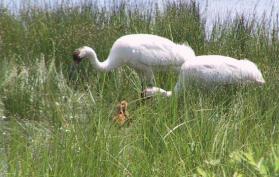 Last week wildlife officials in Wisconsin celebrated the birth of two whooping crane chicks marking the first time in over 100 years that a whooping crane has hatched in the wild in the Midwest.
Last week wildlife officials in Wisconsin celebrated the birth of two whooping crane chicks marking the first time in over 100 years that a whooping crane has hatched in the wild in the Midwest.
“With the hatching of the first two wild chicks from the migratory whooping crane reintroduction, another chapter in wildlife history has been made. The journey took six long years of dedication, vision and believing it could happen — as well as the blood, sweat and occasional tears of the many partners that worked on the project. This is truly the start of a new generation of wild things…and a symbol for restoring our wild places,” said John Christian, co-chair of the Whooping Crane Eastern Partnership.
“This is a long-awaited moment,” said Signe Holtz, director of the
Wisconsin Department of Natural Resources’ Bureau of Endangered Resources,” the success of this effort sets a goal for endangered species recovery efforts everywhere. The partnership of public, private and government organizations that has made this possible shows what can be done when we all pull together with a common goal in sight. These chicks have a long and dangerous road ahead of them, but with luck we’ll see them wing south with their parents this fall.”
Hatching a chick and keeping it alive until it learns to fly are two very different disciplines. The next stage is so dangerous in fact that biologists won’t count the birds as part of the eastern population until they fledge — and that is 80 to 100 perilous days away.
Whooping cranes were on the verge of extinction in the 1940s. Today, only
about 300 birds exist in the wild. The Whooping Crane Eastern Partnership is responsible for the introduction of 63 birds into the wetlands in the eastern United States in 2001. (As reported in GNN) They were taught to follow an ultralight aircraft, which led them on their ancestral migration route from Wisconsin to Florida not traveled by Whooping Cranes for over a century. Today the migration is completed without human.
Many states, provinces, private individuals and conservation groups
have joined forces with and support WCEP by donating resources, funding and personnel. More than 60 percent of the project’s budget comes from private sources in the form of grants, donations and corporate sponsors.



















